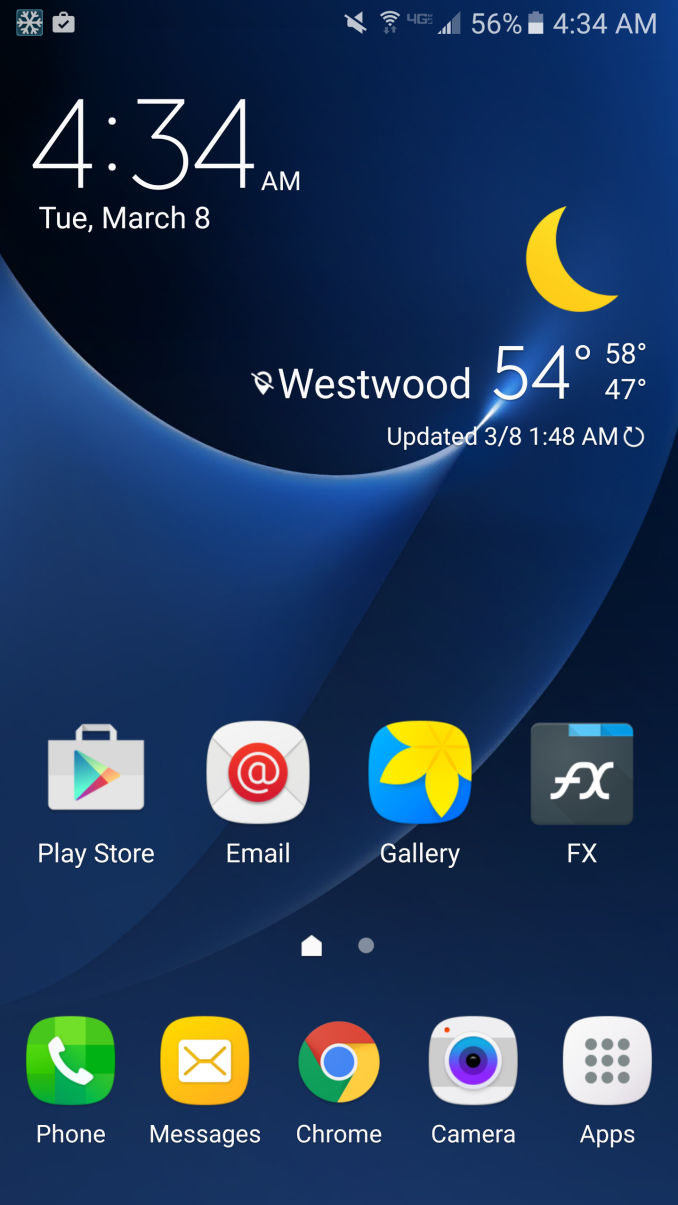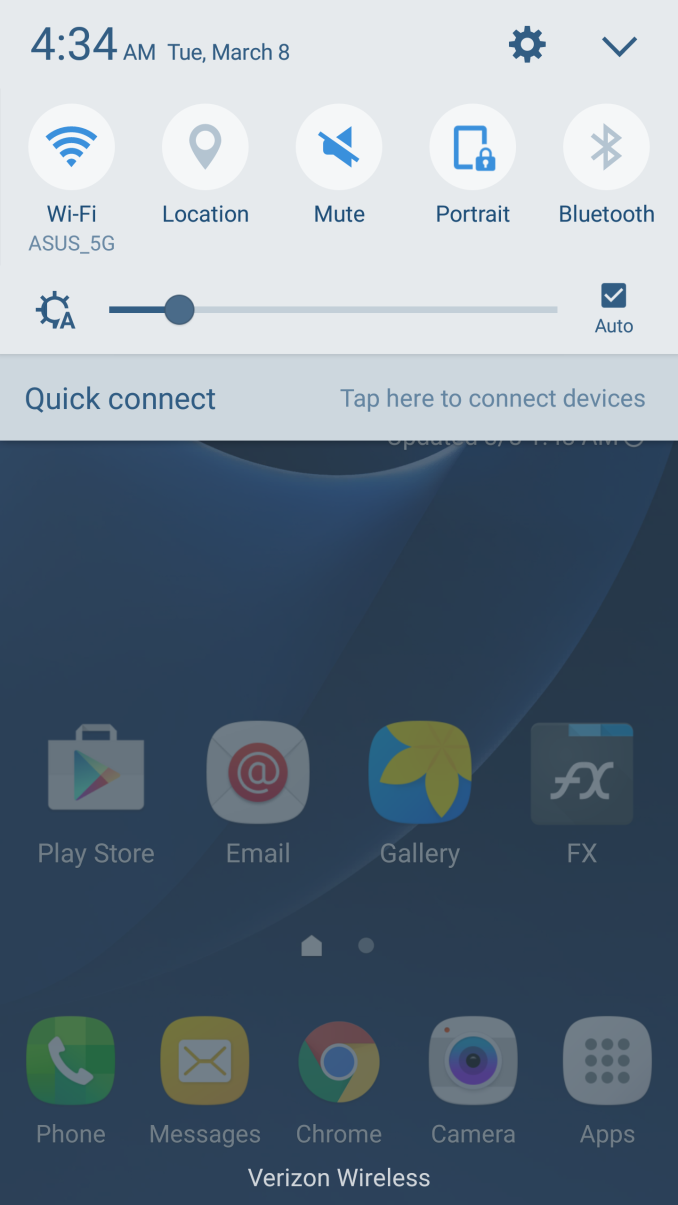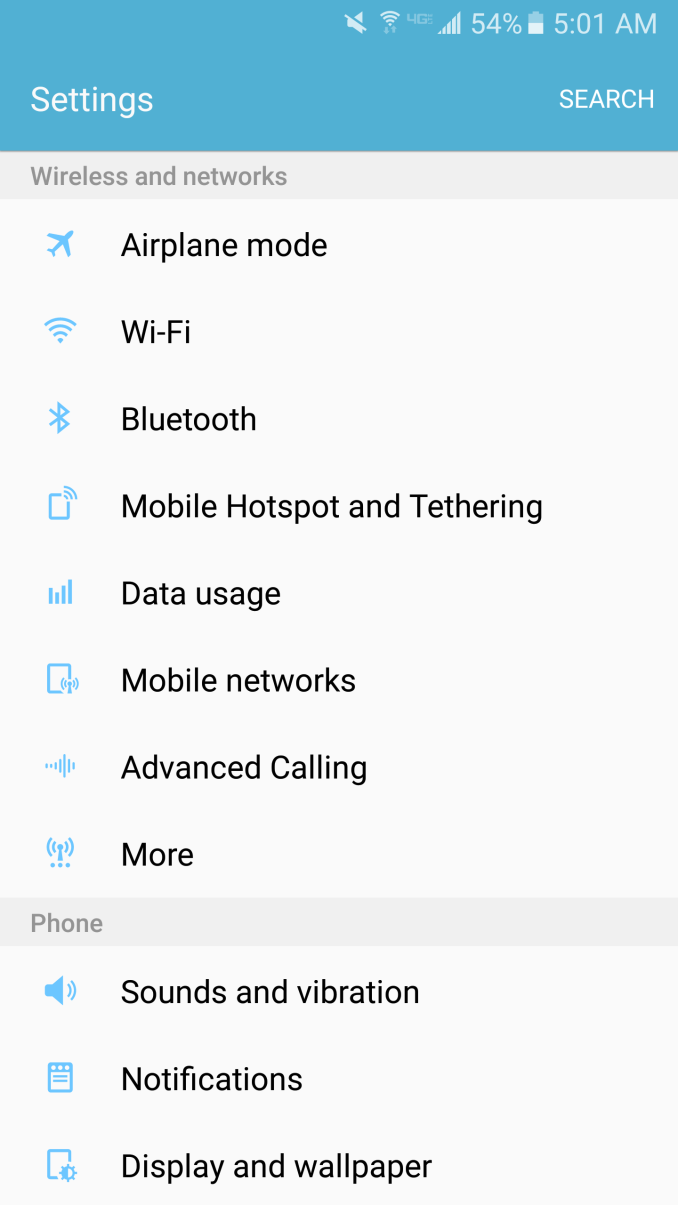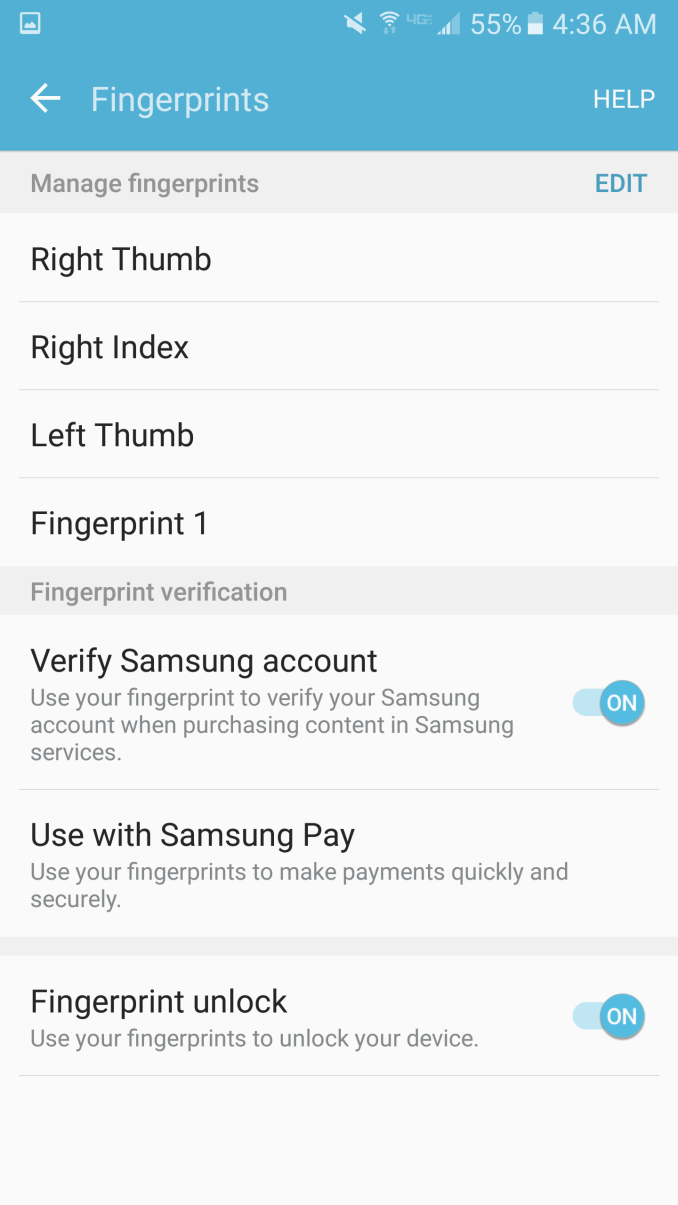The Samsung Galaxy S7 & S7 Edge Review, Part 1
by Joshua Ho on March 8, 2016 9:00 AM ESTSoftware UX
As is always the case, there’s a perpetual debate over the role of the OEM when it comes to Android devices. For better or worse, Samsung seems to believe that they need to add their own framework and UI over Android. To some extent, I suspect that most users are going to find stock Android to be rather spartan out of the box, so it does make sense for OEMs like Samsung to continue adding their own custom applications and frameworks to help differentiate themselves from the competition.
With the Galaxy S5, it was evident that Samsung had dramatically changed their design direction for TouchWiz, but I would argue that their design aesthetic still wasn’t quite perfect, and performance wasn’t completely there either. With the Galaxy S6, Samsung had gotten closer to the mark in some ways, but the continued use of excessively neon colors just made parts of the UI feel off at times, and performance still wasn’t perfect.
With the Galaxy S7, performance has improved noticeably, but it’s really hard for me to say whether this is because Samsung has improved their codebase, or if a faster SoC is just making it harder to notice areas in need of optimization. At any rate, while the Galaxy S7 isn’t perfectly smooth - dropping frames now and then - it is sufficiently performant that you’re not going to find distracting lag.
The default theme of the Galaxy S7 continues to feel pretty similar to the Galaxy S6, so for the most part things are acceptable here, but the use of color is still a bit excessive as a number of icons still use neon colors rather than more neutral pastel colors. Of course, the theme store now has a number of Material Design themes, which greatly improve the situation. I installed one pretty much immediately, which helps make the device feel a lot better in everyday use. However, I’m still of the opinion that this is something that a user shouldn’t need to do out of the box, so this is an area where Samsung can improve.
The other features that Samsung touted for the Galaxy S7 are interesting, but I’m not really sure they’re all that well executed. Always-On Display is nice to have, but for some reason it's quite reluctant to turn off the display when the ambient light sensor and proximity sensor are covered. As a result I turned it off as it’s clearly going to be contributing to idle battery drain in situations where it shouldn’t.
I also found that the fingerprint scanner is pretty much identical to the one in the Galaxy S6, which isn’t entirely surprising as both identify themselves as a Synaptics fingerprint scanner. Both still seem to be quite sensitive to the initial training period and in my experience won’t really work all that well if you don’t cover your entire fingerprint effectively during that period.
Other than this, TouchWiz doesn’t really stand out in any way as of now. Of course, Samsung Pay will be interesting for me to try as I still regularly run into terminals that don’t support NFC in any shape or form, but I haven’t really been able to spend much time testing Samsung Pay yet. I don’t really find TouchWiz to be a bad thing at this point, but I’m not really sure it’s a good thing either. With a serious emphasis on optimization and a major aesthetic overhaul, it’s entirely possible that I could find myself saying quite differently in the near future, but for now if you found the Galaxy S6 and Note 5 OEM UIs to be usable you’ll find the Galaxy S7 to be usable as well.















202 Comments
View All Comments
jjj - Tuesday, March 8, 2016 - link
As for battery tests, as long as you don't simulate a bunch of social, IM, news apps in the backgroud, you can't get close to good results when you got so many diff core configs.retrospooty - Tuesday, March 8, 2016 - link
"s long as you don't simulate a bunch of social, IM, news apps in the backgroud, you can't get close to good results when you got so many diff core configs"You have to have consistent methodology to test against other phones. The point is not to show what you might get with your particular social/newsfeed apps running, the point is to test against other phones to see how it compares under the same set of circumstances so you know which one gets better life.
jjj - Tuesday, March 8, 2016 - link
Sorry but you failed to understand my points.It would be consistent ,if it is simulated.
The point is to have relatively relevant data and only by including at least that you can get such data. These apps have major impact on battery life- and it's not just FB even if they were the only ones that got a lot of bad press recently.
The different core configs - 2 big cores, 4 big cores in 2+2, then 4+4, 2+4+4, or just 8 will result in very different power usage for these background apps, as a % of total battery life, sometimes changing the rankings. Here for example, chances are the Exynos would get a significant boost vs the SD820 if such tasks were factored in.
How many such simulated tasks should be included in the test is debatable and also depends on the audience, chances are that the AT reader has a few on average.
retrospooty - Tuesday, March 8, 2016 - link
And you are missing mine as well... If you have a million users, you will have 10,000 different sets of apps. You cant just randomly pick and call it a benchmark. The methodology and the point it to measure a simple test against other phones without adding too many variables. I get what you want, but its a bit like saying "i wish your test suite tested my exact configuration" and that just isnt logical from a test perspective.jjj - Tuesday, March 8, 2016 - link
What i want is results with some relevance.The results have no relevance as they are, as actual usage is significantly different. In actual usage the rankings change because the core configs are so different. The difference is like what VW had in testing vs road conditions, huge difference.
To obtain relevant results you need somewhat realistic scenarios with a methodology that doesn't ignore big things that can turn the rankings upside down. Remember that the entire point of bigLITTLE is power and these background tasks are just the right thing for the little cores.
retrospooty - Tuesday, March 8, 2016 - link
relevant to who? I use zero social media apps and have no news feeds running at all until I launch feedly. Relevant to you is not relevant to everyone or even to most people. This site is a fairly high traffic site (for tech anyhow) and they have to test for the many, not the few. The methodology is sound. I see what you want and why you want it, but it doesn't work for "the many"jjj - Tuesday, March 8, 2016 - link
Relevant to the average user. I don't use social at all but that has no relevance as the tests should be relevant to the bulk of the users. And the bulk of the users do use those (that's a verifiable fact) and more. This methodology just favors fewer cores and penalizes bigLITTLE.retrospooty - Tuesday, March 8, 2016 - link
Its still too unpredictable. One persons Facebook feed may go nuts all day while anothers is relatively calm. This is also why specific battery ratings are never given by manufacturers... Because usage varies too much. This is why sites test a (mostly) controllable methodology against other phones to see which fares the best. I find it highly useful and when you get into the nuts and bolts, it's necessary. If you had a bunch of phones and actually started trying to test as you mentioned you would find a can of worms and inconsistent results at the end of your work...jjj - Wednesday, March 9, 2016 - link
"Its still too unpredictable" - that's the case with browsing usage too, even more so there but you can try to select a load that is representative. You might have forgotten that i said simulate such apps, there wouldn't be any difference between runs.Yes testing battery life is complex and there are a bunch of other things that could be done for better results but these apps are pretty universal and a rather big drain on resources.They could be ignored if we didn't had so many core configs but we do and that matters. Complexity for the sake of it is not a good idea but complexity that results in much better results is not something we should be afraid of.
10 years later smartphone benchmarking is just terrible. All synthetic and many of those apps are not even half decent. Even worse, after last year's mess 99% of reviews made no attempt to look at throttling. That wouldn't have happened in PC even 10 years ago.
retrospooty - Wednesday, March 9, 2016 - link
I think you are a little too hung up on benchmarks. It is just a sampling, an attempt at measuring with the goal to compare to others to help people decide, but what really matters is what it does and how well it does it. I find it highly useful even if not exact to my own usage. If unit A lasts 20 hours and unit B lasts 16 hours in the standard tests, but I know my own usage gets 80% of what standard is I can estimate my usage will be 16 hours on unit A and 12.8 hours on unit B (give or take). It really doesn't need to be more complicated than that since testing batteries is not an exact science, not even on PC/laptops as usage varies there just hte same. That is why there are no exact guarantees. "Up to X hours" is a standard explanation. It is what it is.